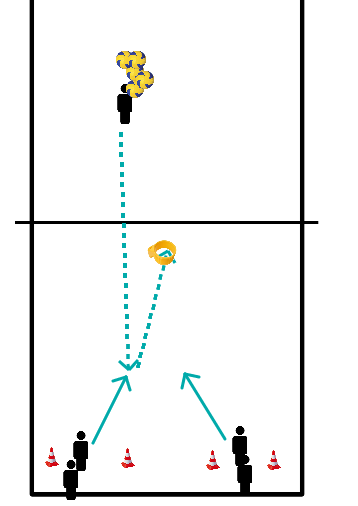Volleyball drills for technique passing / defense / reception
- The important thing is that each 2 team is serious about the drill, and really training each other.
- Doubles play OH, using the benches as a net.
- OH, replay.
- Player 1 throws the ball on close to the bench, after the pass (by player 2), player 2 runs to the back line, taps it, and comes in again.
- Player 1 throws the ball at the backline, after the pass (by player 2), player 2 runs to the bench, taps it and back.
- Same as the first exercise, but player 1 tries to OH the ball 2/3 times himself, and then pass to player 2.
- Player 1 standing on the bench:
- Throwing the ball overhead, a bit harder and tighter if possible. Player 2 tries to pass the ball back.
- Also in motion, shuffle backwards.
- Team is divided into two groups:
- On one side of the field they play 2/2 or 3/3, passing the ball up and down.
- On the other side of the court the trainer starts with the other group.
- Trainer throws in balls, before the rally/service 3-4 handle the ball to position 3.
- On 3 catch and put the ball in the ball bin.
- Short/long.
- Trainer throws balls to the 3 meter line. (positions A + B)
- Player 1 passes the short ball and runs to the middle.
- Player 3 comes in to play the ball.
- Then trainer switches to the other side.
- Player 2 plays the short ball, and goes to the middle.
- Player 1 now goes for the ball on the other side.
- Other players?
- 3 get balls.
- 3 encourage.
- After 10 balls switch groups.
- 2 trainers available?
- 1 trainer makes sure the player in the middle does not cheat by starting too fast. (and keep him/her in the middle).
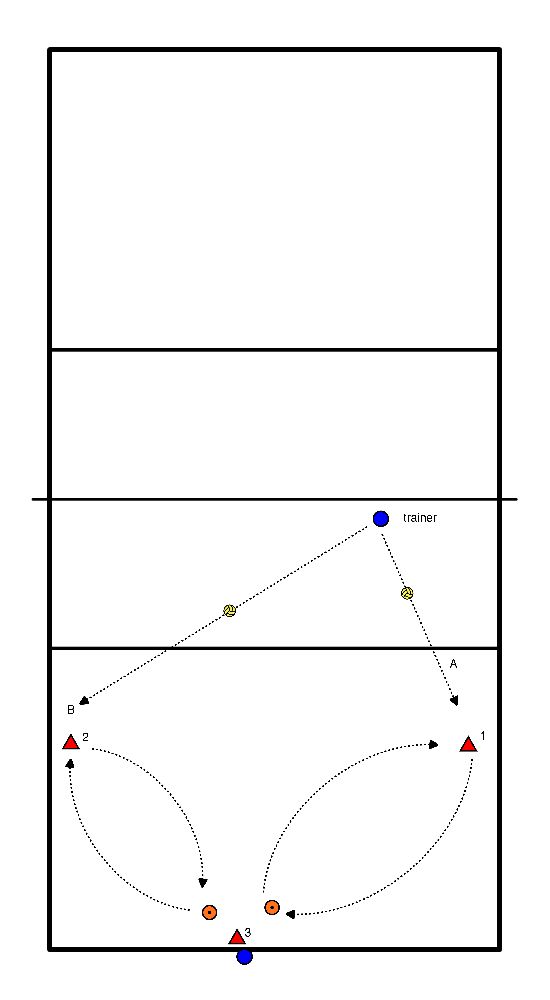
- Organization:
- Field B:
- 2 passers and 1 reserve.
- 1 playmaker on p2/3.
- Field A:
- Defender on 5 and 1.
- Reserve on p5.
- Coach serves.
- Field B:
- Execution:
- Trainer serves.
- Pass and setup to the non-passer.
- Attack thus on p3 or p4.
- Attacker becomes playmaker, passer stays.
- Spare becomes passer and playmaker becomes spare on p5.
- P5 passes to p1 and p1 becomes reserve passer.
- Defended ball is passed to p2.
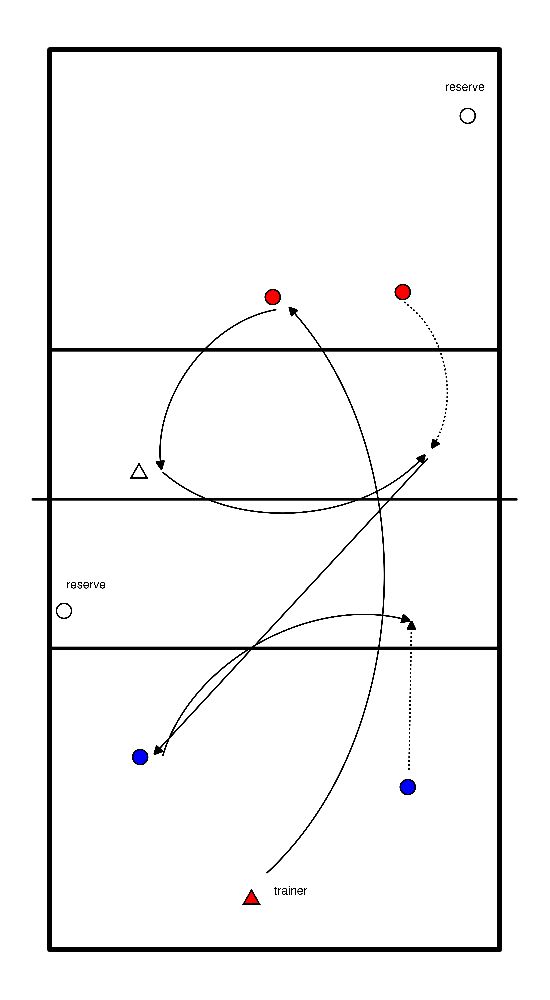
- Exercise to practice posture and movement when playing underhand.
- Players (red circle) shuffle stepping around the pawn in position for underhand play.
- Players then go under the net and play the ball back.
- 10x then change.
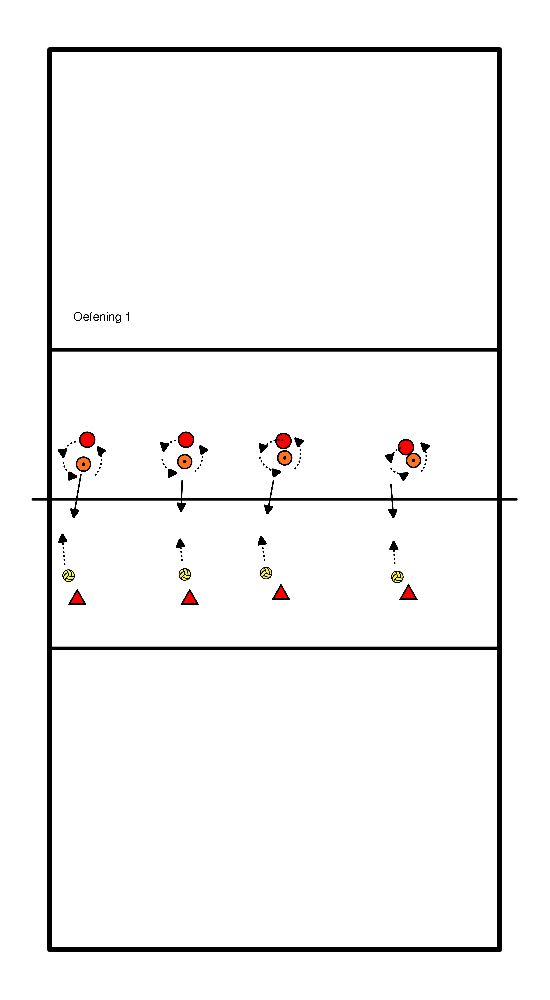
- Player starts with block jump at the net.
- Player then moves into position to defend a ball.
- Player passes the batted ball through the trainer to the catcher.
- Player shuffles around the pawn and defends the next ball.
- Catcher joins the line outside the field.
- Defender goes to catch.
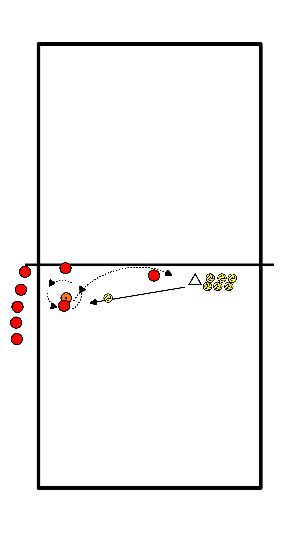
- 2 tals.
- Two teams throw the balls over the net.
- On the other side of the net stand 3 teams, and play alternately.
- The ball is thrown to the ball, and is caught by the passing arms, but not yet played.
- Roll the ball back.
- After 2 times change to the next 2 team.
- Variation:
- Try to play the ball in the box on pos. 3.
- Stand low, feeling in your arms, play quietly.
- Objective:
- Develop ball sense, be able to control ball close to your body.
- Everyone has their own ball, can be combined with a warm-up.
- Let the ball bounce on your right fist.
- Up to maximum eye level.
- Arm is stretched out and is almost horizontal.
- Stay in one place as much as possible.
- Later on, alternate bouncing with your left hand.
- Now do the same while following the yellow lines in a certain pattern.
- The person in front chooses the route (watch out for rear-end collisions!); who wants to take this role? (requires even more concentration and a sense of responsibility a la captain's role)
- Play the ball with only your right hand above your head, up to a maximum of 30cm higher than your hand
- Your upper arm is pointed 45 degrees upwards and your forearm 45 degrees in the other direction; this brings your hand above your shoulder again.
- The ball is played mainly with your wrist and forearm; stay in one place as much as possible.
- Later on, alternate with the left hand.
- Afterwards also in pattern.
- Play the ball in a fixed routine for yourself, for example:
- Square:
- Underhand R, overhand R, overhand L, underhand L, underhand R, ...etc. (change later to the right)
- Cross:
- Lower hand R, upper hand L, upper hand R, lower hand L, lower hand R, ...etc.
- In teams of four (preferably) with each its own ball.
- Stand in a square; all equally spaced.
- Throw the ball to the next person and catch the ball that is thrown to you.
- First throw underhand and catch underhand; then throw abovehand and catch abovehand.
- Then expand by passing 1 ball.
- Choose a spot opposite the wall.
- Sit in front of the wall with your feet against the wall.
- Play overhead against the wall. (Ball just above eye level)
- Pay attention to the movement of the wrist and a little bit of the forearm.
- The ball will only bounce about 10cm this way.
- If necessary, extend the game by slowly standing up, playing standing up for 10 seconds and then sitting down again.
- Let them play a route along the wall: bounce briefly (10cm) and play overhand (right).
- At the end of the route, take a distance of 2 meter from the wall and keep on playing overhand while walking left until the beginning of the route, close to the wall.
- Everyone in line; if you lose the ball, pick it up and go back to the line.
Three balls per two players.
- Throw your own ball and catch it again.
- Third ball is tested over and over again
- Same as in jump pass
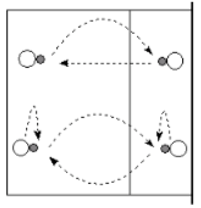
- Trainer strikes ball at pos 1,6.
- Players bring the pass --> SV --> AV.
- Other side defends ball and completes rally
- Space through on both sides
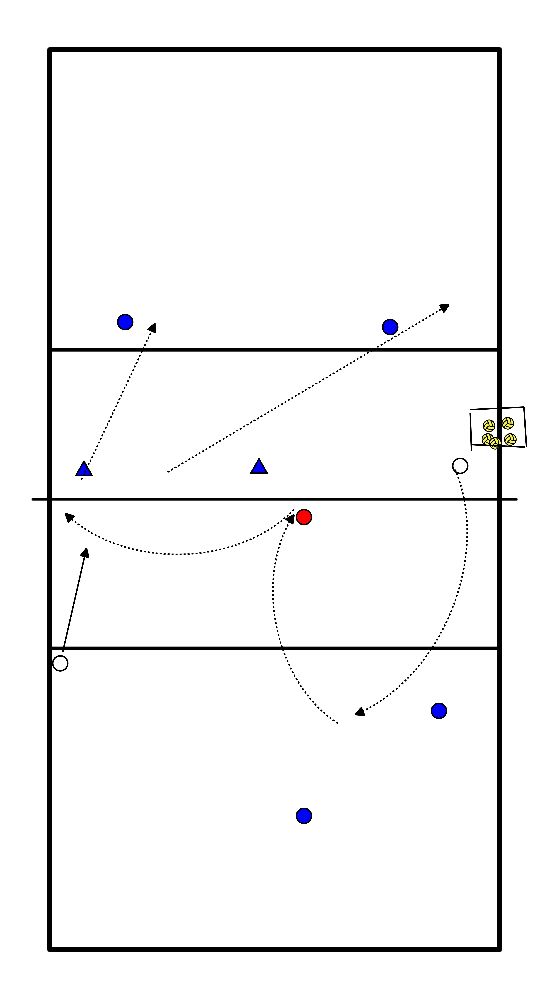
- 2 pairs on both sides of the net with 1 ball
- The ball is played back and forth in threes;
- The back player passes, the front player sets, the back player comes in and plays the ball easily over the net.
- The players at the other side do the same
- Front and back players rotate every time the ball is played over the net.
- After that, a simple attacking stroke and possibly a hard attacking stroke can be added.
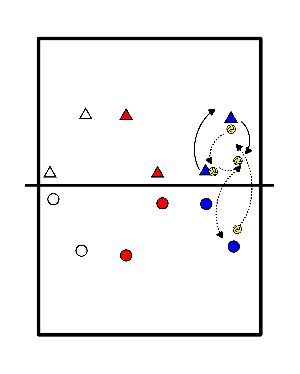
- 2 rows of players
- 1 row on the left back
- 1 row at the right back
- Create with 4 pawns a virtual line where they must stand behind
- Trainer stands at the other side of the net and throws the ball somewhere in the field
- One of the two front row players calls LOS orI (let's agree)
- This player passes the ball over the net to the previous player.
- Catch a round for the next player
- If you did not have the ball, join the shortest row








